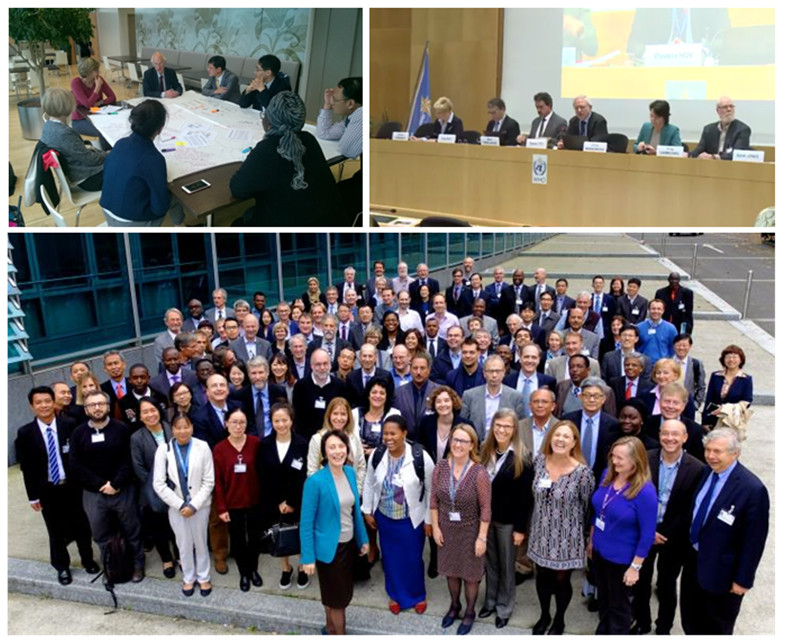 In light of recent natural disasters, including a series of deadly tropical cyclones, floods and wildfires, the WMO’s Commission for Atmospheric Sciences held a “Science Summit on Seamless Research for Weather, Climate, Water and Environment”, which took place from 20 to 22 October 2017 at WMO headquarters in Geneva, Switzerland. The Summit brought together leading scientists from academia, the WMO community and the private sector, as well as representatives from funding agencies. Together, participants outlined a new framework for collaborations to enable breakthroughs in Earth system understanding as well as the transformation of knowledge and technologies into concrete services for society.
In light of recent natural disasters, including a series of deadly tropical cyclones, floods and wildfires, the WMO’s Commission for Atmospheric Sciences held a “Science Summit on Seamless Research for Weather, Climate, Water and Environment”, which took place from 20 to 22 October 2017 at WMO headquarters in Geneva, Switzerland. The Summit brought together leading scientists from academia, the WMO community and the private sector, as well as representatives from funding agencies. Together, participants outlined a new framework for collaborations to enable breakthroughs in Earth system understanding as well as the transformation of knowledge and technologies into concrete services for society.
This event, attended by the Chair and Vice-Chair of the WCRP Joint Scientific Committee, Guy Brasseur and Amanda Lynch, was particularly timely for WCRP, currently undergoing a review by its sponsors and developing its next decadal Strategic Plan.
In keynote talks, panel discussions and breakout debates the participants shared ideas on how to promote local and global exchange across multiple Earth system disciplines. The outcomes of the Science Summit directly fed into the quadrennial assembly of the Commission for Atmospheric Sciences and will guide its proposals to the 2019 World Meteorological Congress, which is the primary decision-making body of WMO.
The Science Summit was structured around five key themes considered central to the development of future research strategies for seamless prediction:
- Seamless prediction in 2023:
One key to improving predictive capacity across weather, climate, water and environment is a holistic Earth system approach to modelling that takes into account atmosphere, ocean, land, cryosphere and their interactions in a seamless way. This calls for a science strategy that considers all compartments of the Earth system and fosters collaboration across disciplines and stakeholders.
- Future infrastructures:
The seamless prediction approach requires planning for and investing in future infrastructures (computing, data-handling, observations), taking into account emerging challenges and opportunities from technical developments. Making data and tools accessible to the broader scientific community can help boosting research as well as the development of methods and services, including in developing countries.
- Science for services:
A new interactive design and science model has to be developed and implemented which ensures the mutual integration of research and operations. Enhanced engagement of end users and the private sector in the development of new services will bring research and operations closer together and create user-relevant services.
- Nurturing scientific talents:
In order for science to sustain its community and have continuous access to talent pools, barriers of geography, gender and age must be overcome. Enhancing accessibility of trainings, tools, data and research results, as well as fostering exchange among researchers can further the contribution of early career researchers, including in the global South. Sustaining successful and integrative science communities also requires opportunities for individual career paths, for example through the provision of family-friendly working arrangements, enhanced job security, and accessible networking activities.
- Innovation and resources:
Advancing the above themes requires catalyzing innovation and mobilizing resources in weather, climate, water and environment research globally and locally. Resource-efficient ways forward will include co-designed and user-tailored project layout along the value chain, the development of public-private partnerships, and close interaction with donors.
Those themes were all highly relevant for WCRP and shall be taken into account when developing the future priorities of the Programme.
Overall, the Science Summit created an inclusive and interactive forum to identify priority approaches to the above mentioned key topics. Its participants outlined a new framework for science cooperation in support of global requirements for weather, climate, atmospheric composition and related environmental research, as well as its translation into new and improved products and services.
For the Summit’s full agenda and other details, including a summary video, see the meeting homepage.
Full, detailed results of the Science Summit and its discussions are currently being synthesized and integrated into a set of upcoming publications – make sure to visit the summit homepage for corresponding updates.

